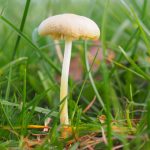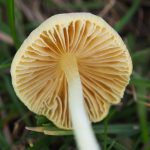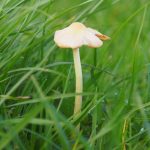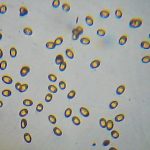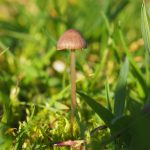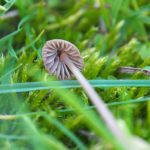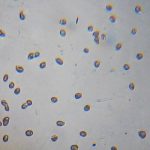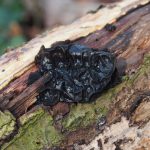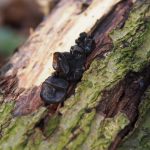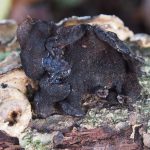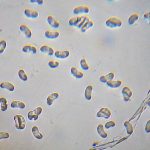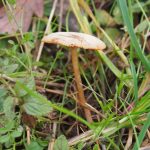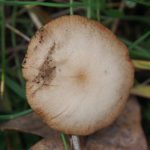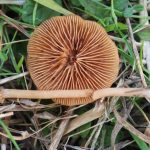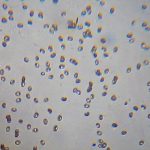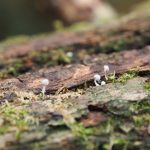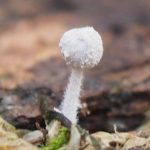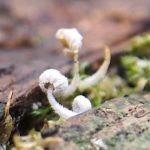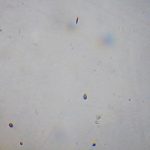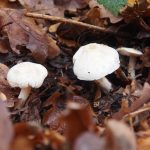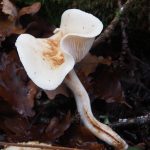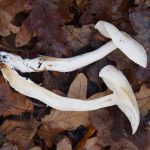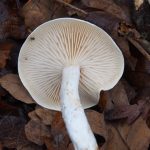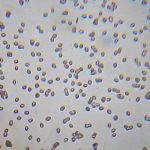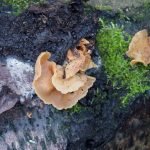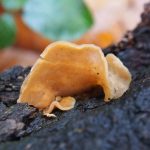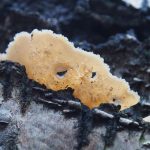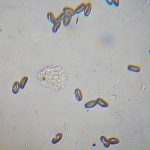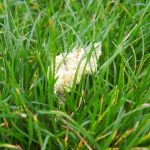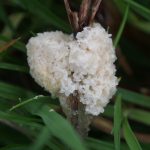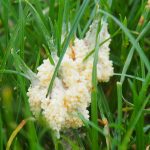Went back to Oxleas but there wasn’t a great deal to see, maybe mid-November is getting a bit too late in the season.
A few highlights: Glad to see lots of Yellow Fieldcaps in the meadow, it’s nice to find a place where a species is abundant. Witches’ Butter is a new find for me. My book says this is thought to be common but very seldom recorded. Conocybe pilosella is new for me as well, though to be honest the id is very shaky. There’s lots of similar looking Conocybes and similar genera. The unidentified tiny, tiny mushroom (no.5 below) was a very exciting find, with a cap around 1mm across! The mycena genera contains many very small species but none of my books or any online resources mention anything with a proper mushroom shape and a 1mm cap, as far as I can see. Frosty Bonnet is pretty damn small but my beauties are significantly smaller than that! Pedicel Cup is one of many similar fungus species with a cup shape and fawn or brown colour – over 100 apparently, so can’t be sure of any identification. Don’t remember ever seeing one like this on a birch log before and Pedicel Cup is commonly found on beech and elm. And lastly, Dog Vomit Slime Mould… I love finding slime mould – it’s a fascinating organism. I don’t find it very often. I expect there’s lots of it around but it just doesn’t gather into bodies very often. Also known as scrambled egg slime, or flowers of tan, and in Scandinavian folklore as troll cat vomit! Is it climbing the grass stems in order to hitch a ride or to spread its spores in the wind better?
1. Yellow Fieldcap (Bolbitius titubans).
- 1. Yellow Fieldcap
- 1. Yellow Fieldcap
- 1. Yellow Fieldcap
- 1. Yellow Fieldcap
Growing in grassy field. Lots scattered widely. Cap 0.5-3cm, stem 3-8cm. No smell. Sporeprint Brown. Spores 9.5-12.5µ x 7-8.5µ.
2. Unidentified.
- 2. Unidentified
- 2. Unidentified
- 2. Unidentified
Growing in grassy field. Only one. Cap 0.5cm, stem 3cm. No smell. Spores 5.5-7.5µ x 4.5-6µ.
3. Witches' Butter (Exidia glandulosa).
- 3. Witches' Butter
- 3. Witches' Butter
- 3. Witches' Butter
- 3. Witches' Butter
Growing on rotting hardwood log. A few blobby clusters. No smell. Floppy ear/cup structures, shiny on top, matt underneath, soft jelly-like. My book says this is thought to be common but very seldom recorded. Sporeprint White. Spores 12.5-16.5µ x 5.5-8µ.
4. Conocybe pilosella.
- 4. Conocybe pilosella
- 4. Conocybe pilosella
- 4. Conocybe pilosella
- 4. Conocybe pilosella
Growing in grassy/mossy field. One only. Cap 2.5cm, stem 4.5cm. Slight mushroom smell. ID is wild guess. Sporeprint Brown? - not enough to be sure. Spores 4.5-7µ x 3.5-5µ.
5. Unidentified.
- 5. Unidentified
- 5. Unidentified
- 5. Unidentified
- 5. Unidentified
Growing on mossy living(?) trunk of broad leaf tree. Several widely scattered. Cap 1-1.5mm, stem up to 4mm. Tiny, tiny, tiny! Spores 4.5-6µ x 3-4µ.
6. Spotted Toughshank (Collybia maculata).
- 6. Spotted Toughshank
- 6. Spotted Toughshank
- 6. Spotted Toughshank
- 6. Spotted Toughshank
- 6. Spotted Toughshank
Growing from leaf litter of oak. Many trooping in large group. Cap 3.5-10cm. Stem 5-10cm. Unpleasant smell. Sporeprint Cream. Spores 4.5-6µ x 3.5-4.5µ.
7. Pedicel Cup (Peziza micropus).
- 7. Pedicel Cup
- 7. Pedicel Cup
- 7. Pedicel Cup
- 7. Pedicel Cup
Growing on rotting birch log. Two. Lobe up to 6cm across. Fungus smell. Floppy lobes with slightly jagged edge. Hard to be sure this is exactly the correct id as there are several similar species and all have varying colours. ID is very likely. Sporeprint White(?) - not enough to be sure. Spores 14-16µ x 7-8µ.
8. Dog Vomit Slime Mould (Fuligo septica).
- 8. Dog Vomit Slime Mould
- 8. Dog Vomit Slime Mould
- 8. Dog Vomit Slime Mould
- 8. Dog Vomit Slime Mould
Growing on stems/blades of grass, or maybe just migrated there. Several blobby masses scattered widely. Around 2cm across. No smell. White or yellow on top with translucent jelly below.

